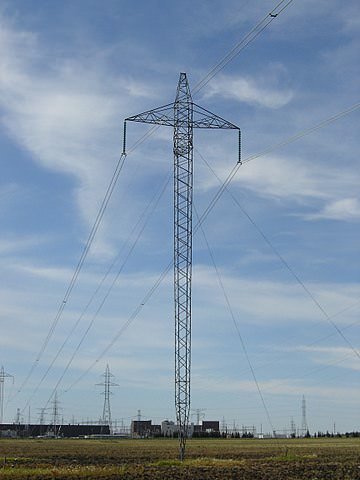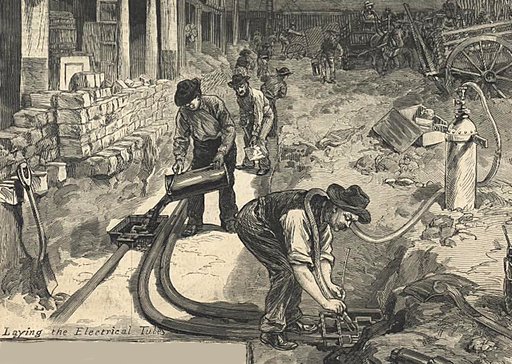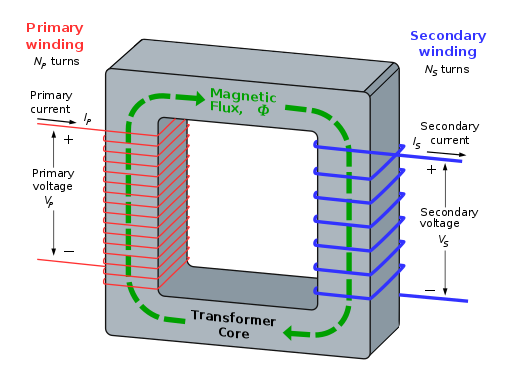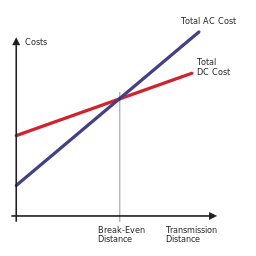HVDC - High Voltage Direct Current
We present the English translation of the post by @knfitaly titled HVDC - High Voltage Direct Current
Translation by @moncia90 revised by the @davinci.polyglot team
HVDC - High Voltage Direct Current

HVDC
High Voltage Direct Current
... notes on technology, history and political scenarios

Nicola Fruet - Knife Maker for passion - Trentino - Italy
…who sometimes (lately often...) comes out of its field.

COVER IMAGE – HVDC AIRLINE - J. Lindsay [GFDL (http://www.gnu.org/copyleft/fdl.html) or CC-BY-SA-3.0 (http://creativecommons.org/licenses/by-sa/3.0/)], from Wikimedia Commons - link image.
HVDC
The HVDC (High Voltage Direct Current) is nothing more than the electric current of a normal battery (DC direct current), but multiplied several times. With the development of technologies, this way of transporting energy is more efficient than the alternating current (AC) that we normally use in our houses and in all industrial activities. Its particular application is in the transport of electricity over long distances, large loads and it is easier to control it because it is a more stable system.
ALL THE DIFFERENCE IS IN "HV"
As it is known, Edison was the promoter of direct current, whereas Westinghouse, head of the Tesla project, developed AC technology. Edison made a defamatory campaigned against the alternating current, considering it dangerous ... everyone remember the episode of the killing of the elephant Topsy, subjected to a discharge of 6600 V in alternating current. [1] In conclusion a real war, however they were playing themselves a mountain of money. The fact is that Tesla's intuition led Westinghouse to win the battle.
Indeed in August 1891 at the exhibition held in Frankfurt, during this event an AC system was built, the power plant was 175 Km away and the current "ran" on a high voltage line (25,000 V) and later in America in 1893 Westinghouse presented its so-called "universal system", the alternating current at the Chicago fair. [2]
The problem of Edison's direct current system were the low voltage of its network (110V was considered a voltage of sufficient security a the time), and the current distribution suffered from losses of energy for this low voltage (the electric voltage)... energy was transformed into heat, the risk of fire was very high, moreover the electric system suffered from other technical problems, in particular from isolation and section of the channel.

By W. P. Snyder (June 21, 1882 Harper's Weekly) [Public domain], via Wikimedia Commons Link image.
Note the size of the conduit and the worker pouring tar at the junction point.
He needed a capillary distribution of electric generators to avoid this, but we remember that they were fed with coal and other fossil energies. Even the growing demand for energy complicated verything. It was necessary to build more powerful systems and a huge opportunity was to exploit hydropower, but the potential energy of water was more distant from the point of use of electricity.
Tesla's intuition was "simple" ... if you increase the voltage, energy losses are less. The technology to make an AC transformer is and was quite simple. In fact the transformer modifies the voltage of the current, bringing it to levels of multiplication of values even several times, when we it use (in the city) we just follow the inverse process to return to the values of voltages normally used.

BillC at the English language Wikipedia [GFDL (http://www.gnu.org/copyleft/fdl.html) or CC-BY-SA-3.0 (http://creativecommons.org/licenses/by-sa/3.0/)], from Wikimedia Commons. Link image.
In the transformer to change the voltage (V) of the current it is sufficient to vary the ratio of turns between primary and secondary.
Let's not forget that the induction motor was developed also with the alternating current, robust, relatively cheap and easy to maintain. Even the same generators that produce electricity in the power plants have less problems than those in direct current.
Edison could not solve the problem efficiently with the continuous current for the physical and technical knowledge of that time. The technology of direct current, however, was never abandoned, but rather was developed precisely to allow overcoming some problems that alternating current had. Obviously, there are pros and cons as in all systems, but the facts have led to the affirmation of alternating current and if today it is still valid it means that the system works.
DEVELOPMENT OF HVDC
As mentioned earlier, the development of DC technology did not stop. Already in 1929 a high-voltage multi-conductor direct current network was developed in Sweden. The system was controlled by mercury vapor valves for high-power current transmission. The Second World War stopped some international developments and projects, we have to reach the 50s to see some projects, one in particular the connection with Sardinia realized in 1965 ** [3] **. We have the greatest development with the technological evolution of semiconductors. Today we can count on technologies that can handle huge DC power and we have a huge advantage in using it for some of its features.
The main benefits of the HVDC system find space if related to the cost of the work, and are valid if:
- The DC connection has lower losses compared to a line with the same AC power, provided that the conduit section is suitably sized. In order to transmit the same power, an HVDC line has a lower cost / length ratio, provided that it considers the greater responsibility of the transformation stations. The transformation stations are complex and particularly onerous, but the continuous development of the technologies manages to contain the costs more and more. The following chart clarifies this dynamic.
- Over long distances particularly large and especially when we have to make a submarine connection. An AC system has problems to overcome 50Km caused by the inductances generated by the network itself.
- To interface different systems. Although there are macrozones with the same electrical system, when we need to connect different systems to each other, the connection in HVDC is the only one that can be used. If we think of a system with a nominal voltage of 220 V and a frequency of 50 Hz (European type) and we have to interface it with a 110 V (American system) and at a frequency of 60 Hz, an AC system can not be used.

By wdwd [GFDL (http://www.gnu.org/copyleft/fdl.html) or CC BY 3.0 (https://creativecommons.org/licenses/by/3.0)], from Wikimedia Commons - Link image.
130/5000
The higher cost supported by an HVDC system must be taken into account to determine the investment economy.
But we also have some advantages in ecological terms, indeed we have a lower visual impact in a line in HVDC. With the same power, a traditional system requires large trusses while they have a smaller size for the DC system. Two HVDC lines with 3000 MW of power are equivalent to five 500 KV AC lines, the same size of a single pylon are significantly smaller. So we think about Italy that has in the landscape one of its key points.
POLITICAL PROJECTS AND SCENARIES
If we make a little research on the net, we will find news and important information on the energy transport projects in HVDC.
Let's think about the DESERTEC project or the corporate strategies of State Grid Corporation of China, who also winked at the blockchain technology, or Saudi Arabia, which is planning a "solar park" project to produce 200 GW of energy under regime ... for those who do not realize the number, I quote that
it is foreseeable that the new global PV power at the end of the year (2017) will be 100.4 GW in aaccording to the Energy Trend forecasts, thanks to the 48 GW that will be installed in China.
Source QualeEnergia.it link , webside seen on 04/18/2018
It means twice the world energy produced in 2017! The country among the richest in oil in the world is preparing for the end of fossil energies. China has activated a series of projects that distinguish it with the mentioned State Grid Corporation of China,
From coal to clean energy. From a dependent country and polluted to an exporting and virtuous country.
Source StartMagazine link , webside seen on 04/18/2018
China is the nation that claims the largest (in global terms) installed power in both coal and photovoltaics, as well as being one of the most important importers of oil resources (gas and crude oil). The State Grid Corporation of China is planning to build a line that will bring clean energy produced from wind and photovoltaics up to Europe, the newspapers have called it the "New Way of Energy" in analogy with the historical and legendary Way of the Silk.
The strategies of some countries, such as China and Saudi Arabia, which have a considerable economic impact on the world level, are to exploit fossil energies as long as they have extraction convenience but in parallel they invest and plan projects of several billions dollars for turn into new energy fields.
What will the new political and economic scenarios be? Which countries will cross these new energy routes? They will undoubtedly have a value as much as the oil-rich countries have today. What will be the true value of this energy? Which countries will "have" or will need to buy energy?
Or maybe ... have they already established it?
REFERENCES AND INSIGHTS
[1] From Blog Techlivingpeople URL used on April 2018
[2] From Production and distribution of electricity by Gian Luca Lapini URL used on April 2018
[3] From Document from thesis by M Schiavinato - 2012 - URL used on April 2018
QualeEnergia.it link, The 2017 record year of photovoltaics: probably over 100 GW - Editorial Board QualEnergia.it
StartMagazine link, Here there are the projects of the State Grid Corporation of China in Europe and in Italy by Giusy Caretto
DESERTEC Project
Energiaoltre link, China ready to "Internet of energy”. Thanks to Blockchain by SEBASTIANO TORRINI
 Imagine CC0 Creative Commons, thanks to @mrazura for the logo ITASTEM. CLICK HERE AND VOTE FOR DAVINCI.WITNESS
Imagine CC0 Creative Commons, thanks to @mrazura for the logo ITASTEM. CLICK HERE AND VOTE FOR DAVINCI.WITNESS